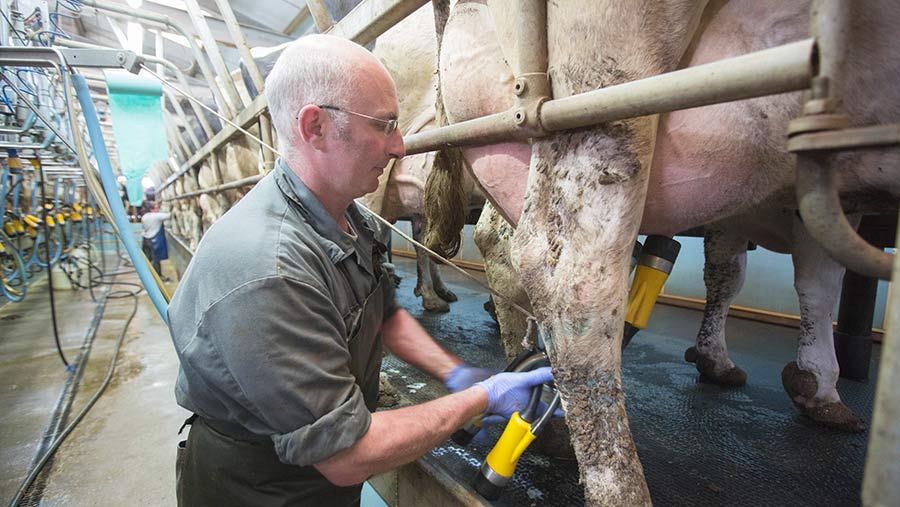What to consider when switching to three-times-a-day milking
 Increasing milking frequency can add more strain if you don't have staff to cover additional milkings © Tim Scrivener
Increasing milking frequency can add more strain if you don't have staff to cover additional milkings © Tim Scrivener Moving to three-times-a-day milking can have benefits for cow health and yield and the hours can be more sociable, but the added costs and extra labour associated with an extra milking shouldn’t be overlooked.
Kite Consulting’s Chloe Cross lists some key considerations farmers should make when deciding on whether to make the switch.
There are multiple benefits to switching to three-times-a-day milking (see Benefits of switching to three-times-a-day milking) but any decision to change the system, must include a close examination of the financial and management impacts of such a move.
1. Labour
Labour should be high up on the list of considerations. This includes the cost of providing skilled milking labour for those extra hours/day, as well as the labour requirement of getting the cows into the parlour, feeding and scraping (if you are doing this at each milking) and washing down the parlour.
With an average cost of £50/milking, can you realistically recruit and retain reliable labour? If you are let down by your night milker(s), you are likely to be the one to fill that gap.
Managed correctly, you can find employees who fit well into a three-times-a-day milking system. Often the hours fit well to accommodate childcare, daytime family commitments and it can work around another job.
On average, the additional labour will cost £18,000/year. For a herd producing 1.5m litres annually, this means an additional 1.2p/litre added to your labour bill.
Advice for making it work
- Organise yourself for cover and emergencies in case someone can’t milk; especially when it comes to the night milking.
- Make sure your parlour is in excellent working order. A cow that is milked three times a day is more at risk from health issues, exacerbated by a poorly maintained milking machine, teat damage from overmilking or liner slippage.
- Cows are also at greater risk of exposure to pathogens if you have an environmental mastitis problem. Cubicle hygiene, slurry management and milking routine are only three areas that must already be faultless to be in the position to successfully milk three times a day.
2. Increased parlour costs
While three-times-a-day milking can fit well into existing parlour facilities, it can increase parlour costs by up to one-third.
If you produce 1.5m litres of milk/year, parlour servicing and maintenance will likely increase by 0.5p/litre on an annual basis. If the facilities are in need of updating, these parlour costs could increase by 1p/litre.
Furthermore, electricity demand will increase (0.8p/litre), dairy chemical use will rise, and wear and tear on the parlour will increase (roughly £3/day). For example, you will find yourself replacing liners more often.
See also: 7 ways to improve cow flow at milking
3. Feed intakes
Additional feed costs are a contentious issue. Yes, the cows will eat more dry matter, but this is not the only limiting factor.
Think of feed like the fuel in your car – bumping up to the more expensive performance fuels isn’t going to all of a sudden turn a Corsa into an F-Pace. The majority of the success will depend on silage quality, housing, staff routine, protocol, hygiene, genetics and youngstock rearing.
Feed intakes will increase by about 5%, but you can make more of an impact by ensuring the rest of your system fits together smoothly.
Summary
Three-times-a-day milking can make financial sense, but considering the overall implications for you, your family and business can be the difference between achieving a successful transition or not.
Benefits of switching to three-times-a-day milking
1. Yield – how much of a response can you expect?
Research has shown that moving to TTAD milking can increase yields by up to 15% (although it usually ranges from 3-5 litres a cow) and while percentage of milk solids may fall, overall production tends to increase.
To begin with, the benefits of milking three times a day will vary based on the response from the cows – should a 9,000-litre herd increase production by 5%, the costs of managing this extra milking will not be offset by the small addition of milk and could result in a financial loss across the business.
However, should the response increase by 15%, the financial gain could reach additional profits of £150-£180 a cow a year based on an average milk price of 27p/litre. This calculation will be driven by your current level of performance, ability to manage staff and by choosing attainable goals for your herd over a realistic timeframe.
2. Health benefits
The increased milking frequency reflects the “natural” way a cow expels milk – little and often for her calf. The udder health benefits of this are well documented, with herds milking three times a day reporting drops in somatic cell counts.
If managed correctly, stress of the cows’ reproductive tract should decrease, which has led to some anecdotal evidence of increases in fertility.
